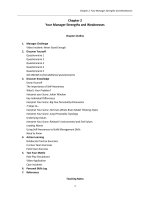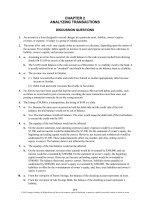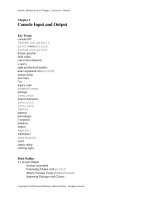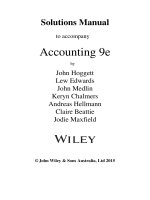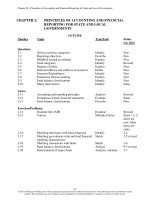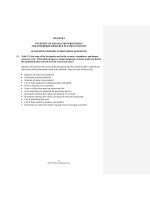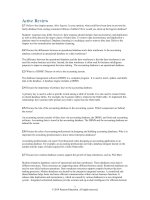Test bank and solution of chemical asect of life (1)
Bạn đang xem bản rút gọn của tài liệu. Xem và tải ngay bản đầy đủ của tài liệu tại đây (262.03 KB, 4 trang )
2
STUDY GUIDE
1. Atoms and Elements
a.
Write the terms that match the phrases in the spaces at the right.
1) Smallest unit of an element.
Atom
2) Positively charged subatomic particle.
Proton
3) Negatively charged subatomic particle.
Electron
4) Subatomic particle with no charge.
Neutron
5) Substance that cannot be broken down into
any simpler substance.
Element
6) Atoms of the same element, with different
numbers of neutrons.
Isotopes
7) Most abundant element in the body.
b.
Oxygen
Label the atom shown by placing the number of the component in the space by the label, then, provide the responses to the phrases below.
a
c
1) Nonvalence electrons
a
2) Nucleus
b
3) Valence electron(s)
12p
12n
b
C
4) Atomic number of this atom.
12
5) Atomic weight of this atom.
24
6) Number of electrons needed to complete its
outer shell.
6
7) Type of chemical bond that is likely to join
this atom to another atom.
Ionic
8) Symbol of this atom.
c.
Mg
Diagram an atom of these elements.
Oxygen
Nitrogen
8p
8n
7p
7n
51
2. Molecules and Compounds
a.
Write the terms that match the phrases in the spaces at the right.
1) Composed of two elements combined in
a fixed ratio.
Compound
2) Smallest unit of a compound.
Molecule
3) Number of chlorine atoms in CaCl2.
2
4) Chemical bond resulting from the donation
of electron(s) from one atom to another.
Ionic
5) Chemical bond resulting from the sharing of
valence electrons by two atoms.
Covalent
6) An atom with a net electrical charge.
Ion
7) The attractive force between a slightly positive
H atom and a slightly negative 0 or N atom.
Hydrogen bond
8) Chemical bonds forming organic molecules.
Covalent
9) Electrons in the outer shell.
b.
Valence electrons
Indicate the kinds and numbers of atoms in a glucose molecule (C6H1206).
Kinds of Atoms
c.
Numbers of Atoms
Carbon
6
Hydrogen
12
0xygen
6
Identify the pH values as acid (A) or base (B). Circle the pH with the highest concentration of H+.
A pH 2.8
A pH 6.8
A pH 3.7
B pH 7.4
B pH 9.5
3. Compounds Composing the Human Body
a.
b.
Identify the following compounds as either organic (0) or inorganic (I).
I
NaCl
0
Lipids
I
CaP04
0
Nucleic acids
I
Salts
0
C6H1206
0
Proteins
I
Most acids
0
CH4
I
Most bases
0
Carbohydrates
I
C02
0
Amino acids
0
Steroids
0
Monosaccharides
0
Fatty acids
0
Glycerol
0
Nucleotides
Write the terms that match the phrases in the spaces at the right.
1) Most abundant compound in the body.
Water
2) Substances dissolved in a liquid.
Solute
+
3) A compound that releases H .
Acid
4) Splitting of ionic compounds into ions.
Ionization (dissociation)
+
5) A measure of the H concentration in a solution.
pH
6) Chemicals that keep the pH of a solution
relatively constant.
Buffers
7) Class of compounds formed of many simple
sugars joined together.
Carbohydrates
52
8) Type of reaction that joins two glucose
Synthesis
molecules to form maltose.
Glycogen
9) Storage form of carbohydrates in the body.
Triglycerides (fat)
10) Composed of three fatty acids and one glycerol.
11) Composed of two fatty acids and a phosphate
group joined to one glycerol.
Phospholipids
12) Type of fat whose fatty acids contain no
carbon—carbon double bonds.
Saturated fat
13) Compound used to store excess energy reserves.
Triglycerides (fat)
14) Class of lipids that includes sex hormones.
Steroids
15) Class of compounds formed of 50 to thousands
of amino acids.
Proteins
16) Chemical bonds that determine the
three-dimensional shape of proteins.
Hydrogen bonds
17) Bonds joining amino acids together in proteins.
Peptide bonds
18) A single-stranded nucleic acid that is involved
in protein synthesis.
RNA
19) Building units of nucleic acids.
Nucleotides
20) Steroid that tends to plug arteries when
in excess.
Cholesterol
21) Sugar in DNA molecules.
Deoxyribose
22) Primary carbohydrate fuel for cells.
Glucose
23) Building units of proteins.
Amino acids
24) Water compartment containing 65% of water
in the body.
Intracellular fluid
25) Molecule releasing energy to power chemical
reactions within cells.
ATP
26) Double-stranded nucleic acid.
DNA
27) Molecules catalyzing chemical reactions in
cells.
Enzymes
28) Type of reaction breaking a large molecule
Decomposition
into smaller molecules.
DNA
29) Molecule controlling protein synthesis in cells.
30) Element whose atoms form the backbone of
Carbon
organic molecules.
c.
Match the four classes of organic compounds with the listed substances.
1) Carbohydrates
2) Lipids
3) Proteins
4) Nucleic acids
3
Amino acids
4
Nucleotides
3
Enzymes
2
Steroids
1
Monosaccharides
4
RNA
1
Glycogen
2
Triglycerides
4
DNA
2
Cholesterol
1
Starch
2
Fatty acids
53
d.
Label the parts of the small portion of an RNA molecule shown and draw a line around one
nucleotide.
3 Nitrogen bases
1
2
Ribose sugars
Phosphate groups
3
1
e.
2
Show the interaction of ADP, ATP, P, and energy in the formation and breakdown of ATP by placing
the numbers of the responses in the correct spaces provided.
P
Q
P
Q
1) ADP
3) Energy from cellular respiration+
2) ATP
4) Energy released for cellular work +
2
3
4
1
f.
Explain the importance of the shape of an enzyme. The enzyme’s active site must fit onto the substrate
in order for the enzyme to catalyze a reaction.
g.
How does a change in pH change the shape of and inactivate an enzyme? A pH change disrupts the hydrogen bonding between amino acids composing an enzyme, changing the shape of the enzyme.
4. Clinical Applications
a. Why does a diet high in saturated fats increase the risk of coronary heart disease? Saturated fats
are more likely to be converted into cholesterol than unsaturated fats. Excess cholesterol forms
plaques in coronary arteries reducing the blood supply to the heart.
b. A patient in a coma is brought to the emergency room. A blood test shows that he has severe hypoglycemia (abnormally low blood glucose) and acidosis. Treatment is begun immediately to increase both blood sugar and pH.
1)
Why is a normal level of blood glucose important?
Glucose is the primary energy supply used
by cells in cellular respiration.
2) Why is severe acidosis a problem?
A change in pH may inactivate vital enzymes.
54
